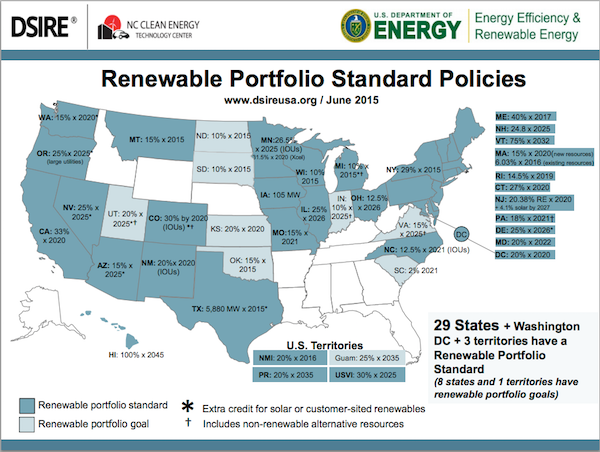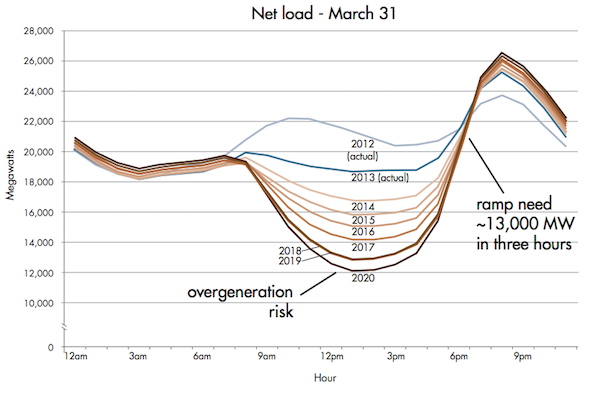This article was published in Scientific American’s former blog network and reflects the views of the author, not necessarily those of Scientific American
Last week, the California State Assembly passed S.B. 350, a provision that would require the state to generate 50 percent of its electricity from renewable sources by the end of 2030. With Assembly approval, the bill’s next stop is Governor Jerry Brown’s desk, where he is expected to sign it into law later this month. The bill comes as one of the most rigorous state renewable portfolio standards to date, signaling California’s commitment to confronting the technical and economic challenges that come with producing a majority of electricity from renewable sources.
Renewable portfolio standards have long been used by the states as a policy mechanism to encourage adoption of renewable energy. The first standard was established in 1983, when Iowa mandated its utilities install 105 megawatts of renewable electric generating capacity. Since then, a total of 29 states have adopted renewable portfolio standards mandating that a portion of their electricity come from renewable sources. Another 8 states have established less-stringent renewable portfolio “goals.”

(Source: DSIRE)
On supporting science journalism
If you're enjoying this article, consider supporting our award-winning journalism by subscribing. By purchasing a subscription you are helping to ensure the future of impactful stories about the discoveries and ideas shaping our world today.
California’s existing renewable portfolio standard already requires utilities and other electric service providers to produce at least 33 percent of their energy from renewable sources by the year 2020. The state’s largest utilities are on track to achieve this goal, producing about 23 percent of their energy from renewable sources in 2013. With the new 50 percent renewable portfolio mandate, California will push utilities to incorporate even more renewable energy into their systems going forward.

California's largest utilities Pacific Gas and Electric (PG&E), Southern California Edison (SCE), and San Diego Gas and Electric (SDG&E) produced about 23 percent of their electricity from renewable sources in 2013. (Source: California Public Utilities Commission)
California’s move to significantly increase the amount of electricity it generates from renewable sources comes on the heels of legislation passed earlier this year in Hawaii requiring 100 percent of the state’s electricity to come from renewable sources by the year 2045. Put together, California and Hawaii’s new, more rigorous mandates signal a shift in the way renewable portfolio standards are used to impact the electricity system. While previous standards were meant to ensure a portion of electricity comes from renewable sources for energy security and environmental reasons, California and Hawaii’s mandates are meant to promote a paradigm shift in the way electricity is generated, delivered, and produced.
The California grid operator (CAISO) has already expressed concerns that the additional solar energy required to meet the state’s existing 2020 renewable portfolio standard could throw off the grid’s operation during the middle portion of the day, when solar production is highest. In its now famous “duck curve,” CAISO forecasted how increasing solar production would impact the net load (electric load minus renewables production) that must be met by conventional power plants, and found that net load would likely transition from mostly flat today to highly variable in the future.

The California grid operator (CAISO) has projected that growth in solar energy required to meet the existing 2020 renewable portfolio standard will lead to "overgeneration" of solar energy in the middle portion of the day and rapidly increasing demand for electricity from conventional power plants in the early evening. (Source: CAISO)
Because solar energy production peaks in the early afternoon, when electricity demand is low, the grid operator is concerned it will have to temporarily shut down base load power plants to make room for extra solar. Because these plants weren’t designed to turn on and off in response to fluctuations in electric load, there is concern they could be pushed beyond their operating limits, threatening the reliability of the rest of the grid. Furthermore, right as solar production begins to decline in the early evening, millions of Californians return home from work and increase their demand for electricity. To compensate for the simultaneous decline in solar and increase in demand, conventional power plants would have to increase their power output at a rate far greater than is typical today, potentially pushing those plants beyond their operating limits.
To produce 50 percent of its electricity from renewable sources and comply with the proposed mandate, California will have to rethink how it produces and delivers electricity to customers—and that’s exactly what the California legislature and Governor Jerry Brown are betting on. California has already mandated that utilities install 1,325 megawatts of energy storage capacity by the year 2020, and the state has been a leader in strategies to promote customer engagement, like the diffusion of smart meters and demand response, where customers are asked to temporarily reduce their energy use in exchange for payment.
Will California be able to meet its ambitious renewable energy goal? It depends on the efficacy of the strategies they implement to cope with the variable nature of renewable energy. Regardless, the rest of the country will certainly be watching.